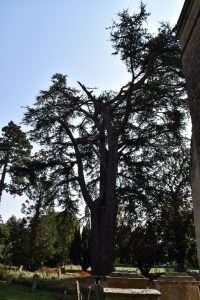
Once again Witney Town Council finds itself in the unenviable position of having to carry out the felling of a veteran tree that has become dangerous. The Cedar of Lebanon (Cedrus libani) in St Mary’s Churchyard has dropped several large limbs over the last 2 years, damaging and further endangering Grade II listed tombs, memorials, and other structures.
The Town Council, which is responsible for maintaining the churchyard, has been monitoring the tree’s health, but despite remedial works undertaken by the council’s retained tree works contractor, the decline in the health of the tree is irreversible. The huge tree is likely to be around 200 years old.
Following the most recent failures, Witney Town Council commissioned a firm of local Arboricultural Consultants, experts in managing and preserving the landscape and environment, to provide an assessment of the risks and available management options.
Unfortunately, the 18m tall tree has lost much of its vitality, the crown is thinning (over a quarter has been lost), and it presents a high risk of further shedding of fractured boughs, predominantly from the canopy. Following bat and other surveys that showed the tree was not being used as a habitat, it has been recommended to remove the tree completely.
Given the age and visual impact of the tree it is likely to leave quite a gap in the churchyard and there will be a lot of wood to remove as a result of the felling. There are hopes to repurpose as much as possible with St Mary’s Church hoping to salvage some of the wood to use for internal and external furniture. Meanwhile, the Town Council’s Estates team is investigating having a memorial bench created somewhere close by along with the possibility of work by professional woodcarvers installed on The Leys.
Councillor Owen Collins Chair of the Stronger Communities Committee remarked,
“The Cedar of Lebanon has been a presence on the Witney skyline for decades, so it’s an enormous shame that it is now both irreversibly unhealthy and thus unsafe. However, we’re committed to replacing the cedar, and making good use of the wood, so that after 200 years in Witney it can live on for many more years yet!”
Although not a true native of the UK, having been introduced in the late 1700s, the Cedar of Lebanon has become commonplace on large estates, and especially in Churchyards where their familiar evergreen branches have strong biblical connections.
Once the tree is removed the Conservation Officer has requested that a replacement Cedar of Lebanon is planted as close as possible to the original site. It should be good for another 200 years!
